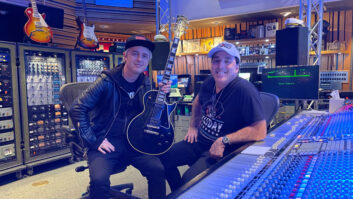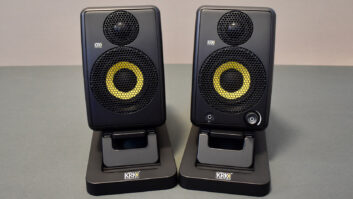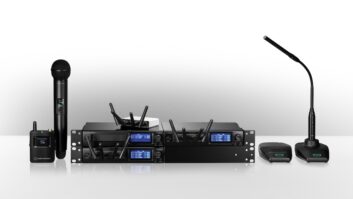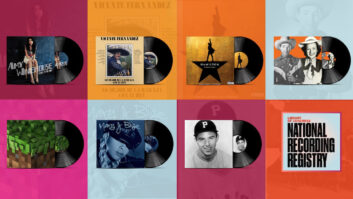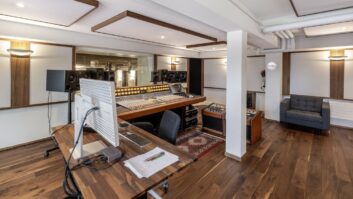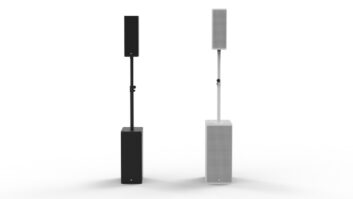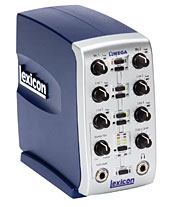

Lexicon seems like an unlikely candidate to throw its hat into the large ring of relatively inexpensive, computer-centric recording systems currently available. But if an industry heavyweight decides to offer a package with the flexibility and value that the Omega achieves, why ask why? With a list price of $499, the system is really three components for the money: the Omega, Cubase LE and the Lexicon Pantheon VST reverb plug-in.
THE ALPHA AND OMEGA
The Omega — an 8-input, 4-bus, 2-output USB I/O mixer — represents the core of the system. Sturdily constructed out of silver and blue plastic and sporting red, blue and green LEDs, the squat Omega has a 7×3.25-inch footprint and bears a striking resemblance to Star Wars’ R2-D2.
A closer look at the uncluttered front panel reveals a surprising amount of features and functionality. Two mic-level input potentiometers control up to 50 dB of input gain for the unit’s corresponding dbx Silver Series XLR mic pre’s, and are equipped with peak indicators and bus assigns that allow the user to assign the inputs in pairs to the four USB buses. Moving down the panel, four similarly equipped line-level pots do the same for Omega’s four RF-filtered TRS active balanced inputs, with maximum input of up to +22 dBu. Below that, the monitor mix pot conveniently allows balancing between live input and the playback mix level, and is flanked by a knob controlling the overall output level with a 2-channel, 4-segment assignable bar graph meter for monitoring exact levels at the A/D converters in between. At the bottom are an ultra-hi-Z instrument input (which overrides line input 3 if both are plugged in), a ¼-inch headphone output and a S/PDIF assign button for routing to USB buses 1 and 2.
Flip the Omega around and cute turns to brute: The rear panel is a no-nonsense array of connectivity. Four of the aforementioned line inputs are on top and accept either balanced or unbalanced signals on the way to 24-bit A/D converters. The XLR mic pre’s each have their own -20dB pad and TRS insert for outboard processor connectivity, with one phantom power switch for both. Beside the XLRs are two ¼-inch RF-filtered TRS servo-balanced outputs and MIDI I/O. S/PDIF I/O, the USB port and external power supply connector round out the package.
A key feature in the Omega package is Cubase LE, a stripped-down version of Steinberg’s DAW Cubase suite. While featuring 48 audio and 64 MIDI tracks, support of up to eight VST instruments and two insert/four effect sends per channel, it lacks Cubase SX’s higher track count and effects capabilities, as well as numerous functions such as Freeze and surround support. However, LE does share SX’s intuitive user interface and smooth operation. As a longtime Cubase user, I felt instantly at home.
Experienced recordists who prefer another DAW may not want to use Cubase, however, and they won’t have to as Omega serves as a USB audio device that any platform will recognize. They will, however, want to leave Cubase LE on their system as it serves a vital function as the host for Lexicon’s Pantheon reverb VST plug-in. While the choicest algorithms remain reserved for the company’s higher-end systems, there’s still no question that Pantheon is a killer reverb with the creamy goodness for which Lexicon is famous.
IN THE FIELD
As both a field recording solution for my Dell laptop (running Windows XP and a 1.7GHz Pentium processor with 256 GB of RAM) and a supplemental audio device for my IBM tower (Windows XP with a 2.26GHz processor and 1 GB of RAM), I quickly became hooked on Omega’s capabilities. Installation of drivers and recognition of hardware on both machines went smoothly, with all my software (Cubase, Reason, Acid, SoundForge) immediately capable of making the switch to the Omega.
As a frequent headphone mixer, I immediately heard a major improvement over my soundcard in Omega’s headphone amp, which sports a very open sound and plenty of power. Subsequently, the unit shined in a variety of recording and mixing applications. The hi-Z and line inputs cleanly recorded instruments, and the dbx mic pre’s delivered a very clear and transparent sound for male and female vocals, a bass cabinet and percussion instruments. While they don’t deliver the meaty analog warmth of a tube mic pre, they’re not intended to: Omega is geared to quickly capture an accurate 16- or 24-bit signal into your computer.
I’M IMPRESSED
For overall ease of use, Omega and its mixer-based architecture (as opposed to a patchbay structure) is an absolute pleasure. Between its assignable buses and well-thought-out interface, it just goes where you point it for highly intuitive portable or desktop recording/mixing.
I would have appreciated separate phantom power switches for each XLR input, as one for both presents a limitation of its own. Lexicon Pantheon is application-specific to Cubase LE, but the company says it will open in other Steinberg apps. There is also no custom carrying bag, although a laptop bag does easily hold everything.
When you take into account the fact that VST reverb plug-ins of Pantheon’s quality can easily sell for $200 or more, the addition of the extremely flexible and handy I/O box — not to mention Cubase LE — makes the Lexicon Omega an outstanding value. Now if I could just get that hologram of Princess Leia to stop showing up.
Lexicon, 801/568-7567, www.lexiconpro.com.
David Weiss is Mix‘s N.Y. editor.

Click here for the complete specs for Lexicon’s “complete recording solution.”
Need help setting up your Omega?Click here for instructions on how to set up and configure Mac OS X (including Cubase LE/Tiger issues), Windows 2000 and Windows XP applications.
